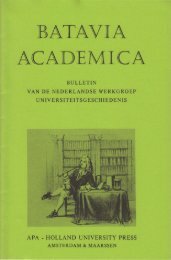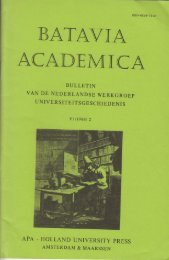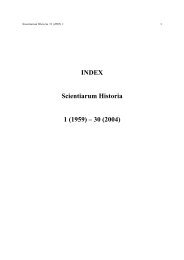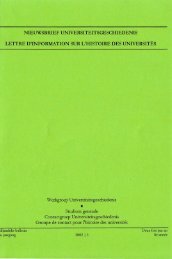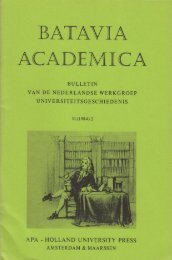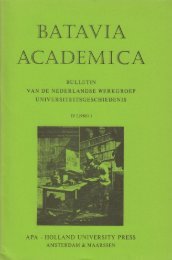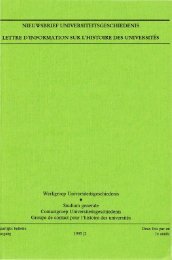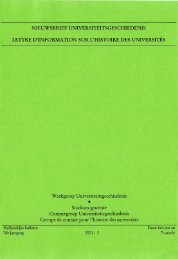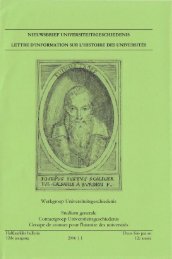the ocular harpsichord of louis-bertrand castel - Gewina
the ocular harpsichord of louis-bertrand castel - Gewina
the ocular harpsichord of louis-bertrand castel - Gewina
Create successful ePaper yourself
Turn your PDF publications into a flip-book with our unique Google optimized e-Paper software.
Castel's <strong>ocular</strong> <strong>harpsichord</strong> 37<br />
Castel's <strong>harpsichord</strong> in France.<br />
Shortly before Castel's death, however, <strong>the</strong> <strong>ocular</strong> <strong>harpsichord</strong> had been<br />
introduced into England by an unknown associate <strong>of</strong> Castel. In 1757 this man<br />
published a leaflet, entitled Explanation <strong>of</strong> <strong>the</strong> ocidar <strong>harpsichord</strong>, in which he<br />
recorded some <strong>of</strong> <strong>the</strong> history <strong>of</strong> <strong>the</strong> instrument and also his own solution to <strong>the</strong><br />
problem.*^ The description he gives <strong>of</strong> his instrument is quite detailed: it<br />
consisted <strong>of</strong> a rectangular box <strong>of</strong> about 170 by 100 by 60 cm, placed on top <strong>of</strong> a<br />
normal <strong>harpsichord</strong>. In <strong>the</strong> front it had fifty elliptic windows <strong>of</strong> transparent<br />
enamel, which were ht from behind by some 500 candles. When a key was<br />
pressed, <strong>the</strong> window with <strong>the</strong> corresponding colour would glow up, but how this<br />
was achieved <strong>the</strong> author did not say, although he did indicate that even <strong>the</strong><br />
difference in propagation velocity between light and sound had been taken into<br />
account! The author, however, had taken one crucial step away from Castel's<br />
<strong>the</strong>ory, in adopting Newton's "minor scale", connecting <strong>the</strong> colour violet with <strong>the</strong><br />
note D. But did this author succeed where Castel had failed? There is much<br />
reason to doubt it. The copy <strong>of</strong> <strong>the</strong> Explanation in <strong>the</strong> British Library has a<br />
written comment <strong>of</strong> its original owner, saying: "The Idea <strong>of</strong> this Instrument is<br />
something very extraordinary, not to say Extravagant; I was admitted among a<br />
select Party to a sight <strong>of</strong> it at <strong>the</strong> Great Concert Room in Soho Square; but to a<br />
sight only <strong>of</strong> <strong>the</strong> instrument, for nothing was <strong>the</strong>n performed nor afterwards, as<br />
ever I heard, nei<strong>the</strong>r did I ever know why.""<br />
More daring was an adaption <strong>of</strong> Castel's project which had been proposed<br />
already quite early in Germany. In 1743 Johann Gottlob Krijger, a pr<strong>of</strong>essor at<br />
<strong>the</strong> university <strong>of</strong> Halle, published a paper entitled "On a new kind <strong>of</strong> music,<br />
enjoyed by <strong>the</strong> eyes,"** in which he severely criticized Castel's views on colour<br />
music. For Castel's <strong>ocular</strong> <strong>harpsichord</strong>, as Kriiger knew it showing, at <strong>the</strong><br />
pressing <strong>of</strong> a key, a strip <strong>of</strong> coloured silk lit from behind by candles, could<br />
imitate <strong>the</strong> melodic aspect <strong>of</strong> music but not <strong>the</strong> harmonic aspect. There was no<br />
convincing analogue <strong>of</strong> a chord. This is not to say that Kruger rejected <strong>the</strong> idea<br />
<strong>of</strong> colour music in itself; according to him it was clear "that our mind, in judging<br />
<strong>the</strong> pleasure or displeasure <strong>of</strong> <strong>the</strong> things that reach our eyes, follows <strong>the</strong> same<br />
laws and rules that are followed in distinguishing musical consonance from<br />
dissonance".*' This fact, however, could not be explained by any physical<br />
Explanation, pp. 17-22. The leaflet was reviewed in <strong>the</strong> Memoires de Trevoux, January 1759,<br />
pp. 342-357.<br />
^ British Library, shelf nr. 1041.h.4.(l.)<br />
Kruger, "De novo musices."<br />
Ibid., p. 352: "animum nostrum in diiudicanda obiectorum, quae oculum afficiunt, suavitate &<br />
molestia, easdem observare leges, easdemque regulas, quibus in distinguendis consonanttis a<br />
dissonantiis musicis uti consuevimus".



